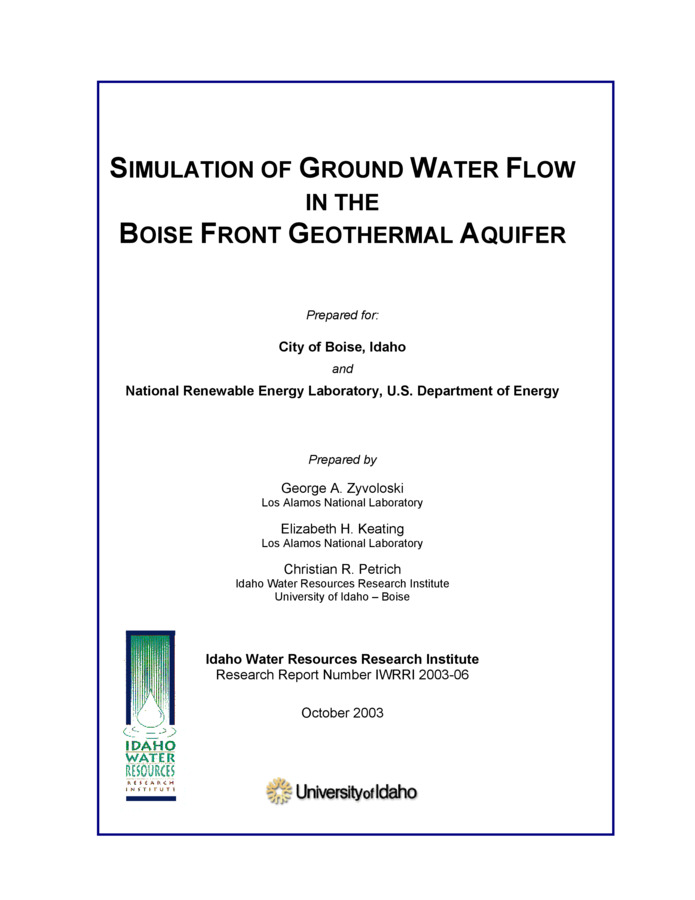PDF
Simulation of groundwater flow in the Boise Front geothermal aquifer. Research report number IWRRI 2003-06 Item Info
- Title:
- Simulation of groundwater flow in the Boise Front geothermal aquifer. Research report number IWRRI 2003-06
- Authors:
- Zyvoloski, George A.; Keating, Elizabeth H.; Petrich, Christian R.
- Date:
- 2003-10
- Description:
- Simulations of the Boise are geothermal aquifer were conducted to determine if increased injection at the City of Boise injection well would affect the temperatures and/or water levels in other primary geothermal wells. The simulations were conducted using the FEHM computer code (Zyvoloski et al., 1997) and the PEST parameter estimation code (Doherty, 2000). The model area included the Harris Ranch, downtown Boise-Table Rock, and Stewart Gulch areas. The geothermal aquifer in this area consists of a complex series of tilted, fractured, faulted, volcanic rocks an interbedded sediments. Recharge was simulated as upward flow in fault areas and lateral flow into the model domain across the northeast boundary. Outflow included lateral flow across the southwest model boundary and discharge wells. The model grid represented a 3-dimensional flow system, with the finest discretization in the downtown Boise-Table Rock area. The model was calibrated to selected 1984 through 1992 water level data, and checked against 1984 through 2002 water level and temperature data. Scenario simulations were run for 30 and 100 years from the present, and consisted of (1) current pumping rates (base case), (2) a 50 percent increase in City of Boise withdrawals (with all increased withdrawals being re-injected). Simulation results suggest that the hydraulic impact of increased pumping/injection, if any, will be minimal. Simulations did not predict appreciable water level declines at the observed wells associated with the increased City of Boise pumping and withdrawals over the base-case simulations. Simulations of increased withdrawals and injection showed minimal impact on inter-annual head fluctuation at the Boise Warm Springs wells. The simulations indicated a possibility of some long-term temperature declines (as much as 3 degrees C, or 6 degrees F, in thirty years). Of the wells included in the model, the only wells showing any thermal changes were the CM#1 and VA Production wells.
- Subjects:
- hydrogeology geothermal resources wells computer models computer simulation
- Location:
- Boise Front; Southern Idaho
- Idaho County:
- Ada County
- Latitude:
- 43.6
- Longitude:
- -116.148
- Collection:
- Boise Basin
- Source:
- Idaho Water Resources Research Institute, University of Idaho
- Identifier:
- IWRRI Number 200306
- Publisher:
- Idaho Water Resources Research Institute, University of Idaho
- Contributing Institution:
- University of Idaho
- Type:
- Text
- Format:
- application/pdf
- Cataloger:
- KIT
- Language:
- eng
Source
- Preferred Citation:
- "Simulation of groundwater flow in the Boise Front geothermal aquifer. Research report number IWRRI 2003-06", Idaho Waters Digital Library, University of Idaho Library Digital Collections, https://www.lib.uidaho.edu/digital/iwdl/items/iwdl-200306.html
Rights
- Rights:
- In copyright, educational use permitted. Educational use includes non-commercial reproduction of text and images in materials for teaching and research purposes. For other contexts beyond fair use, including digital reproduction, please contact the University of Idaho Library Special Collections and Archives Department at libspec@uidaho.edu. The University of Idaho Library is not liable for any violations of the law by users.
- Standardized Rights:
- http://rightsstatements.org/vocab/InC-EDU/1.0/

